|
The Polk RTi28 is a small (.25 cu ft) conventional two-way that has proven very popular and can be purchased for as little as $200 a pair. Its predecessor received a rave review in Stereophile, being cited as the best speaker available for less than $800. Curiosity prevailed, and I picked up a pair from Crutchfield thinking I could always return them if they were complete dogs. It was obvious as soon as I lifted one out of the (inadequate) shipping boxes that these were not your run-of-the-mill-spare-every-expense-el-cheapo wonders. They weighed as much as most DIY speakers of this size, and inspection showed that the cabinet construction was unimpeachable -- 3/4" mdf, a solid shelf brace, and real cherry veneer. The grills were a little cheesy (shiny black), but they were fabricated to minimize diffraction effects, and the speakers definitely measured better with them in place.
My initial listening impression was that they were very open and detailed in the highs with decent bass. They were extremely sensitive -- an honest 89 dB. But after a few minutes, it also became obvious that there was too much energy in the upper mid-treble, and not enough baffle step compensation. There was also a depression in the upper midrange response that accentuated the treble peak. My measurements confirmed these listening impressions. The on-axis response was tilted up, and the off-axis plots showed a bunching of Energy between 4 kHz and 6 kHz. In short, these things had been voiced to jump out at you in your local audio showroom as soon as the hired help switched them on. I couldn't live with the sound, particularly on massed orchestral music with lots of brass.
But the price was too low and the cabinet too good for a quick return trip to Crutchfield. So I disconnected the stock crossover (a little printed circuit board with 2nd order electrical filters low pass and high pass, electrolytic caps with a mylar bypass for the tweeter), measured the drivers, modeled the stock crossover, and experimented with alternatives.
The drivers proved very well behaved except for a woofer hump around 1k, which I assumed was a diffraction artifact caused by the woofer's location nearly equidistant from three sides. The stock crossover point is very low--around 2100 Hz. The acoustic slopes of the woofer and tweeter are not symmetrical. The woofer begins rolling off quite early, due to a very high shunt capacitor value, but the slope is not very steep. The tweeter rolls off quite steeply starting at about 4 kHz, and its swift descent coupled with the woofer's early roll-off leaves a hole in the summed response just below the crossover point.
My final revised crossover uses symmetrical 4th order slopes crossed at about 3 kHz, which provides a reasonably flat on- and off-axis response ignoring the peak at 1 kHz. I did not try to fix that completely since I wanted a simple, inexpensive crossover that would not boost the bargain price of the RTi28 significantly. My replacement crossover has only one more component than the stock, and that's just a resistor.
Here are the predicted on-axis responses of the stock and revised crossover as modeled in LspCAD.
Stock:
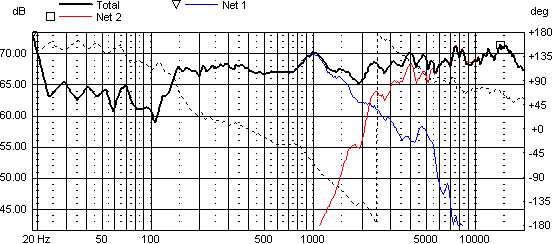
Revised:
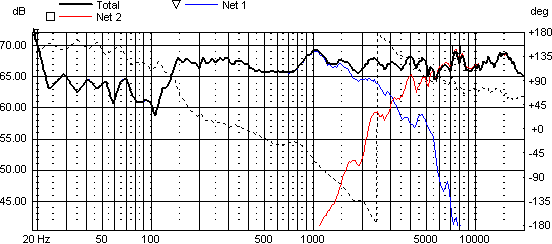
Here is the actual measured on-axis response of the stock Polk:
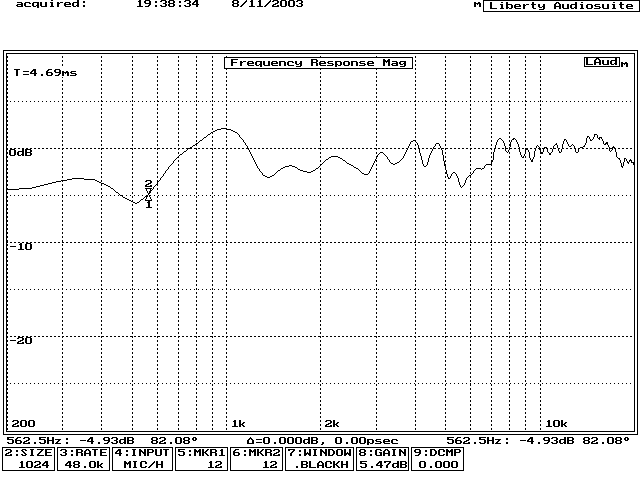
And the response with the new crossover:
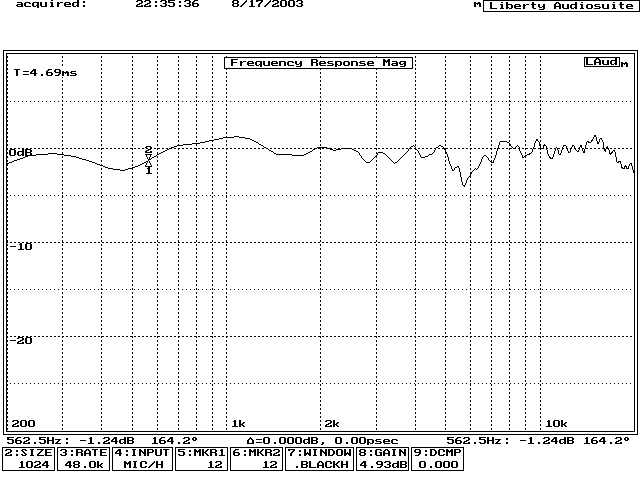
The reduced hump at 1k is partly due to increased baffle step compensation, but I also replaced the wad of poly fill in the woofer cavity with foam lining, and moved the poly up to the tweeter chamber above the brace. I think that also helped to smooth things out.
Here is the stock response at about 20 degrees off axis. Note that the midtreble stands out from the rest of the response profile:
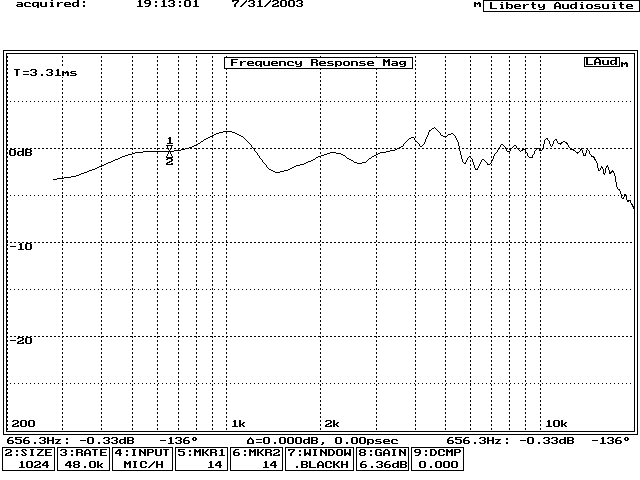
And with the revised crossover:
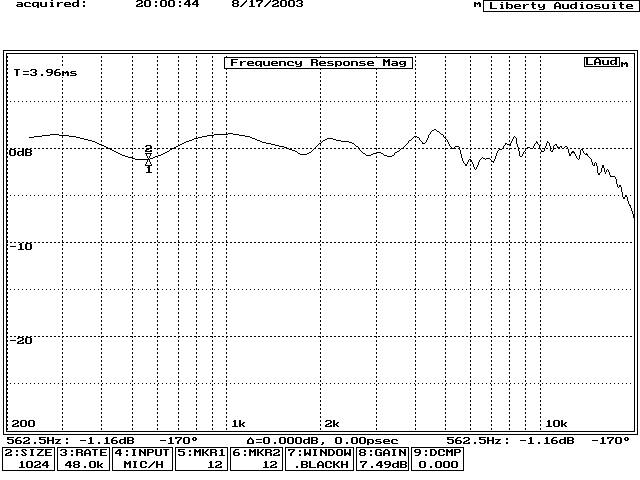
Finally, here is the response with the revised crossover when the tweeter leads are reversed. This shows that the woofer and tweeter were in phase around the crossover region with the correct connections, and also shows the crossover point of about 3 kHz.
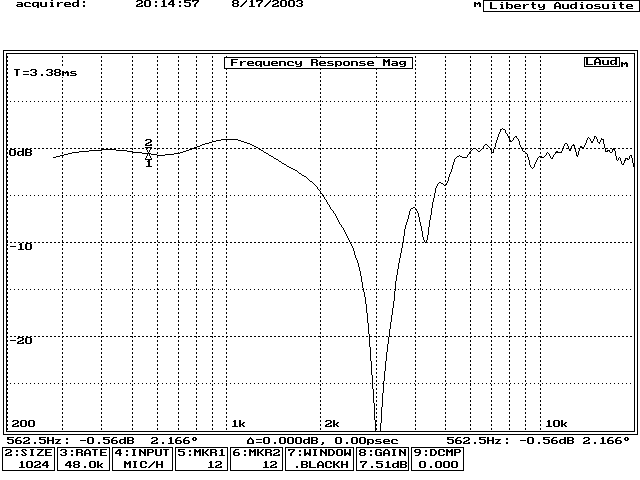
The proof is in the listening, of course, and there were no surprises. The revised Polk sounds balanced and clean. It's a very nice speaker that I plan on using in my office. If you like to make cabinets and countersink drivers, then there's no reason to consider the Polks. A lot of DIY designs will equal or surpass them for not a lot more money. But if you would like to whip together a home theater system (these things are shielded) with a minimum of fuss and $$$$, the Polks are a real find.
Here is the schematic for the revised woofer crossover. The .4 ohm resistor before the woofer inductor doesn't really exist. That's just the dcr of the coil itself, and don't worry if the indicated dcr for the inductor you want to buy is higher than .4. But the 2 ohm resistor before the .30 mH tweeter shunt inductor is very real and critical to the design.
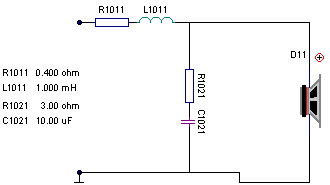
And here is the schematic for the new tweeter crossover:
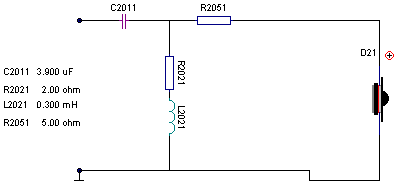
If you are interested in the Polks, here is what you do:
1) Find someone selling them for $200 a pair. Try Crutchfield, or do a Google search if they've raised the price.
2) Take them out of the box and remove the grills. Is the tweeter smashed in? Both of mine were, due to the inadequately padded shipping containers. If so, work out the dents with your finger.
3) Listen to them. Like what you hear? If so, QUIT! Don't touch them. You are home free.
4) If you think improvement is needed, remove the terminal cups and clip the wires about 2" from the attached crossover board.
5) Order replacement terminals (Parts Express, part # 260-303) and keep the old ones in case you want to go back to the original design. Don't try and remove the stock crossover board and use the old terminals. You will break things.
6) Order the new crossover parts -- don't use exotic caps and coils. That's not in the spirit of this thing. Just get decent 16 or 18 Ga air core inductors and mylar or inexpensive poly caps, and maybe some Eagle resistors from Madisound. The total cost PER PAIR with Bennic poly caps, Madisound standard 16 Ga air core coils, Eagle resistors, and the PE terminals should be about $32 plus shipping.
7) Build the new crossover, which will mount on the bottom of the cabinet. So measure how much area you will have free there, and design the layout so there is no large component sticking up at the front--the woofer won't fit if there is. The amount of free area will depend on whether you replace the wad of fill in the woofer cabinet with convoluted foam on the sides and back, or even BlackHole5 (or a cheap substitute). If you do replace the fill, move it to the tweeter chamber (but don't obstruct the path to the rear port).
8) Wire up the new crossover. Make sure you don't mess up the tweeter polarity. The black tweeter wire is positive. The white wire is negative. The woofer wiring is obvious--the red wire is positive, the white is negative.
9) Listen. Hate it? Check your work, and if you didn't make a mistake, wire up the old crossover and don't e-mail me. Like it? Throw out the old crossover and e-mail me.
| 
